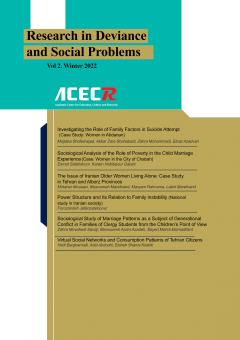Power Structure and Its Relation to Family Instability (National study in Iranian society)
Subject Areas : Social issues and injuries related to women and the family
1 - Associate Professor of Sociology, IHSS, Iran.
Keywords: Power structure, family instability, attitude to divorce, marital conflict, degree of freedom of action.,
Abstract :
The structure of power in the family is an important issue that affects the stability of the family. In recent decades, various changes have taken place at different national levels and also within the Iranian family, which has left an impact on family stability. The main purpose of this article is to investigate the relationship between power structure and its relationship with family instability in Iran. This study has investigated the relationship between two variables using the secondary analysis method of 3819 married people in the National Family Survey data. The structure of power in three indicators of power construction, freedom of action and exercise of power, the method of exercising power with relevant sub-indicators and family instability in three indicators at the levels of action (marital conflict, and violence) and attitude (attitude to divorce) were studied under sub-indicators. Findings show that while the overall power structure in the Iranian family is significantly symmetrical, some indicators of power such as freedom of action and the exercise of power and methods of exercising power have significant effects on marital conflict, violence and divorce attitudes and increase family instability. In order to reduce divorce and increase family stability, it is necessary to allocate various programs and services, including counseling, etc., to families with more marital conflicts and families where more violence is reported. Men and women also have different attitudes toward the power structure and attitudes toward the consequences of divorce, and women are more tolerant of the consequences of divorce.
آبوت، پاملا؛ کلر والاس (1396) جامعه شناسی زنان، ترجمه منیژه نجم عراقی، نشر نی.
اعزازی، شهلا (1380) خشونت خانوادگی یا زنان کتکخورده، نشر سالی، تهران.
----------- (1383) ساختار جامعه و خشونت علیه زنان، رفاه اجتماعی، سال 4، ش 14، پاییز.
افشار کهن، جواد و محمود رضائیان (1397) مقایسه بین نسلی رابطه نظام ارزشی افراد و نگرش به پایداری خانواده، جامعه شناسی نهادهای اجتماعی، دوره پنجم، ش 12، پاییز و زمستان.
امانی، رزیتا (1394) مقایسه تعارض زناشویی در ساختار توزیع قدرت در خانواده، فصلنامه زنان و خانواده، سال دهم ش 32، پاییز.
ایمان، محمدتقی؛ لیلا بهمنی (1391) تأثیر اشتغال زنان بر ساختار توزیع قدرت در خانواده مطالعه موردی شهر شیراز، فصلنامه تخصصی علوم اجتماعی دانشگاه ازاد، سال ششم، پیاپی، 19؛ زمستان.
بگرضایی، پرویز؛ حبیب الله زنجانی و سیف سیف اللهی (1396) فراتحلیل مطالعات خشونت شوهران علیه زنان در ایران، فصلنامه زنان و خانواده، سال پانزدهم، ش 38، بهار.
راش، مایکل (1377) مقدمهای بر جامعهشناسی سیاسی، ترجمه منوچهر صبوری، سمت.
زارعی توپخانه، محمد؛ جان بزرگی، مسعود؛ احمدی محمدآبادی، محمدرضا (1392) بررسی رابطه ساختار قدرت در خانواده با کارآمدی آن، روانشناسی دین، سال ششم، ش 3، پاییز.
ساروخانی، باقر؛ لیلا دودمان (1393) ساختار قدرت در خانواده و تأثیر آن بر مشارکت اجتماعی در شهر شیراز، جامعهشناسی جوانان، سال اول، پیش شماره 1.
سازمان ثبت احوال( 1397) www.
sabteahval.
ir.
سازمان ثبت احوال( 1399) www.
sabteahval.
ir.
سفیری، خدیجه؛ راضیه آراسته (1387) بررسی رابطه سرمایه اقتصادی زنان و روابط دموکراتیک با همسرشان، تحقیقات زنان، سال دوم، ش1، بهار.
سلیمانی، مریم؛ ثریا عظیمیان؛ علیمحمد نظری؛ کیانوش زهراکار (1394) رابطه ساختار قدرت خانواده، تعارضات زناشویی و سلامت روان در مردان بازنشسته اداره آموزش و پرورش استان البرز، سالمند، دوره 10، ش 4، زمستان.
کاوسی، زهرا (1392) بررسی ساختار قدرت در خانواده و رابطه آن با خشونت با تأکید بر موقعیت زنان مطالعه موردی زنان متأهل شمال غرب تهران، پایاننامه کارشناسی ارشد، دانشکده ادبیات و علوم انسانی دانشگاه خوارزمی.
کلاهی، محمدرضا؛ فاطمه شفیعی (1396) تجربه روایتشده زنان از ساختار قدرت در خانواده، فصلنامه انجمن ایرانی مطالعات فرهنگی و ارتباطات، سال سیزدهم، ش 48، پاییز.
لنسکی، گرهارد؛ جین لنسکی (1369) سیر جوامع بشری، ترجمه ناصر توفیقیان، تهران، انتشارات و آموزش انقلاب اسلامی.
مختاری، مریم؛ معصومه کردی پور(1391) بررسی ساختار قدرت در خانواده بر حسب برخی ویژگیهای فرهنگی در خانواده؛ مورد مطالعه زنان متأهل شهر آبدانان، فصلنامه فرهنگی تربیتی زنان و خانواده، سال هفتم، ش 20، پاییز.
مهدوی، محمدصادق؛ حبیب صبوری خسروشاهی (1382) بررسی ساختار قدرت در خانواده، مطالعات زنان، سال اول، ش 2، تابستان و پاییز.
موحد، مجید؛ حلیمه عنایت؛ مرضیه مردانی (1391) مطالعه عوامل زمینهای مرتبط با ساختار توزیع قدرت در خانواده؛ نمونه موردی زنان متأهل شهر شیراز، فصلنامه مطالعات و تحقیقات اجتماعی، دوره اول، ش 3، پاییز.
نایبی، هوشنگ؛ میمنت گلشنی (1392) تأثیر منابع در دسترس زنان بر قدرت تصمیمگیری در خانواده مطالعه تجربی شهر بابل، زن در توسعه سیاست، دوره 11، ش 1، بهار.
نبوی، سید عباس (1379) فلسفه قدرت، سمت، قم، پژوهشکده حوزه و دانشگاه.
Babcock, J. C. , Waltz, J. , Jacobson, N. S. , & Gottman, J. M. (1993). Power and violence: The relation between communication patterns, power discrepancies, and domestic violence. Journal of Consulting and Clinical Psychology, 61(1).
Chowdhury, Soumi Roy; BoharaBrady, Alok; Horn, P (2017) Balance of Power, Domestic Violence, and Health Injuries: Evidence from Demographic and Health Survey of Nepal, World Development, 2017. 09. 009.
Coleman, Diane H. ; Straus, Murray A. (2007)Marital Power, Conflict, and Violence In a Nationally Representative Sample of American Couples, Violence and Victims, Volume 1, Issue 2.
Koester, Diana (2015) Gender and Power six links and one big opportunity, https://www. dlprog. org/opinions/gender-and-power-six-links-and-one-big-opportunity.
Lindahl, Kristin M. ; Malik, Neena M (1999)Observations of Marital Conflict and Power: Relations with Parenting in the Triad, Journal of Marriage and Family, Vol. 61, No 2, May.
Weber, Max (1978) Economy and Society, Ed. Q. Roth & C. Withich, University of California Peress.


